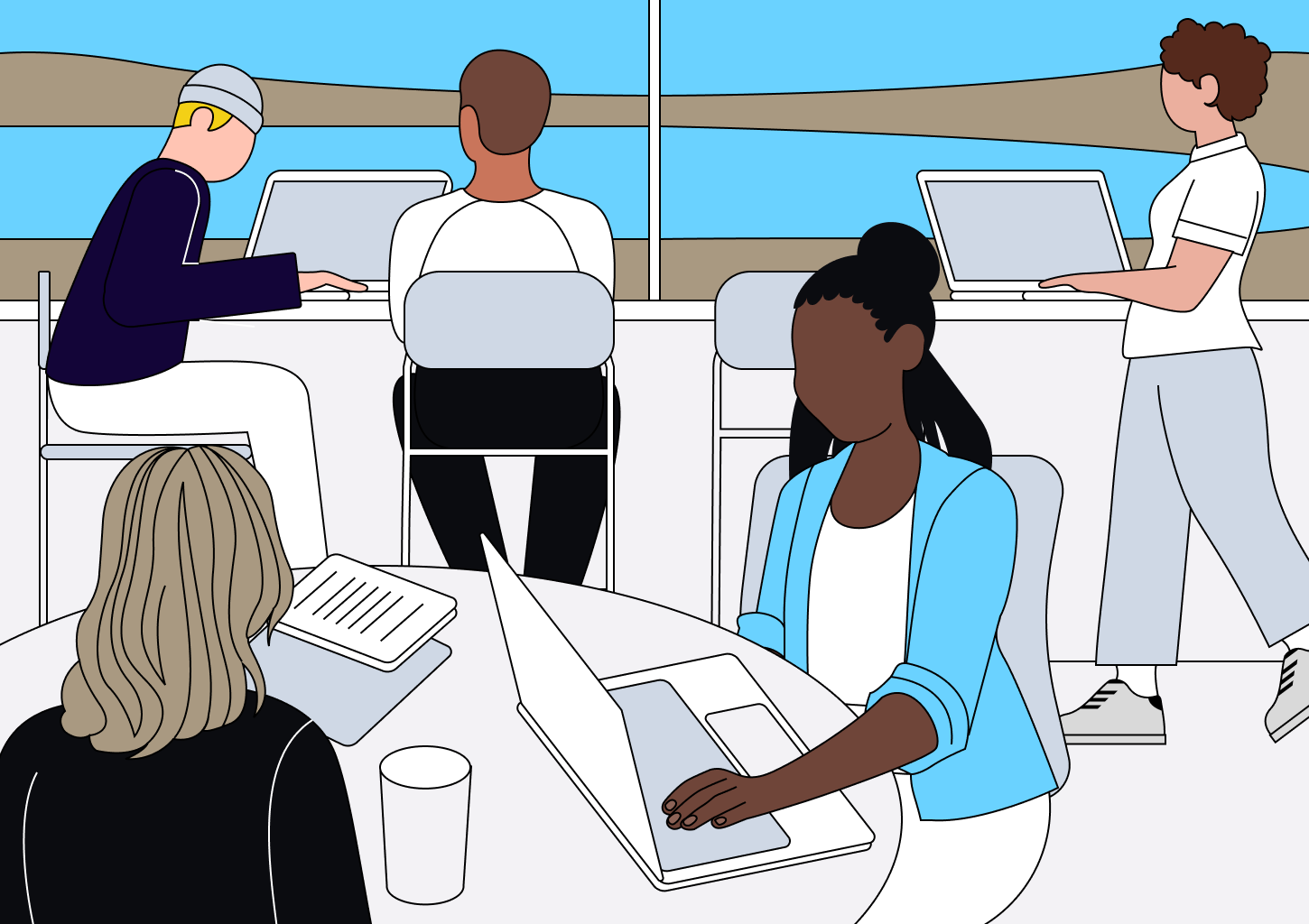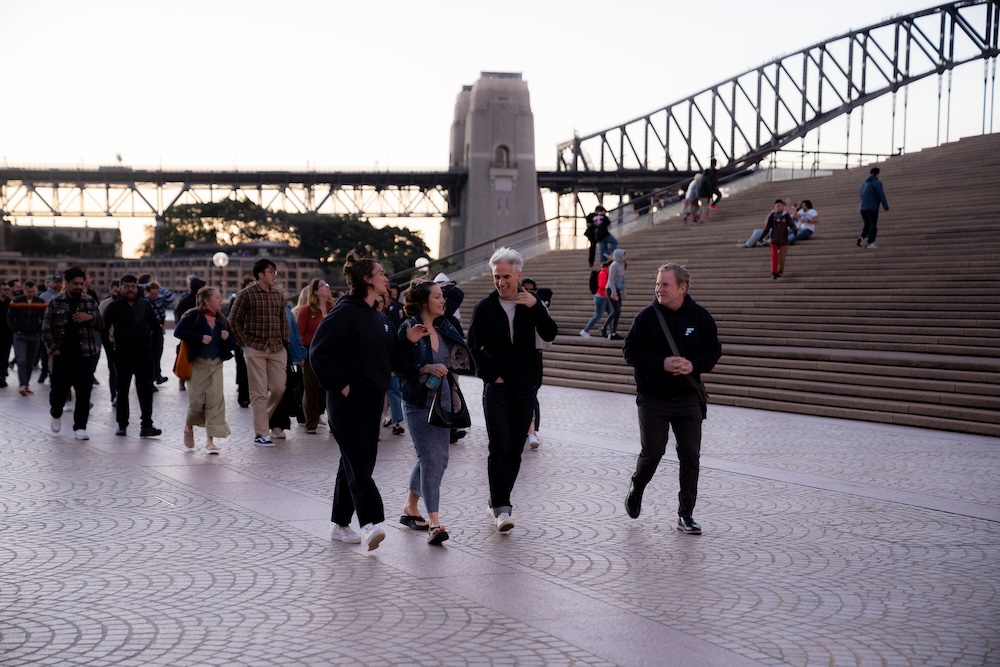When remote teams meet in person, new strengths emerge

At ∞µÕ¯…´«È∆¨, we‚Äôre proudly 100% remote by design and by DNA. Clear written communication, autonomy, and thoughtful collaboration are the cornerstones of skills that help us to thrive day-to-day in an async remote environment.
Most of our collaboration happens in our carefully chosen tools like Figjam boards, Linear comments, Notion pages, and Slack groups—not meeting rooms. When we do meet, it's virtual and usually via a Google meet or a Slack huddle. For many of us, that rhythm feels natural: it gives us the space to think, write, recharge, and set our own pace. Working autonomously isn’t just encouraged, it’s a critical skill for our team.
Once a year, when we meet in person for our annual all-team meetup, a whole new environment and way of working come into play. With optional co-working days (that this year nearly 90% of folks opted into) and some departments having dedicated strategy and workshop days, getting together and being co-located can actually feel really strange for a lot of us!
We‚Äôre not used to having desks right next to each other ü´£ Some of our department groups have dedicated team days. For the Commercial group, spending four hours together sharing information and problem-solving is a new experience. Engineering‚Äôs day is about six hours of presentations and workshops, which is a big leap from our usual async rhythm. For us, a #bestworklife means having the agency to design a day around our own energy levels, focus times, and the balance between personal and work needs. The official meetup spans two days: one conference day and one social day, each about seven hours long. That‚Äôs a significant demand on everyone‚Äôs attention and time, especially when we‚Äôre used to working autonomously, on our own schedules, and with most meetings capped at an hour.
When we’re onsite at the meetup, our environment and schedules change completely, and new skill sets come into play. Suddenly, the way we connect, collaborate, and communicate looks different. We shift from remote to in-person, from async to in-the-moment, and the skills that make us great remote teammates don’t always map directly to being great in-person teammates.
Together, these moments ask us to flex muscles that many co-located teams use every day, but for us, they’re not skills we need daily. These are the skills we’ve had to flex and adapt most when shifting from async to live, and remote to in-person collaboration:
1. Public speaking
We use Loom, a lot. It allows us to put a face to our comms and to articulate complex ideas more clearly. We also get all the bonuses of async comms like editing for impact, removing filler words, or re-recording until you get the message right. It's this refining that help us to express ourselves in our best way.
When we do present live, for example, at our Town Halls (which are also recorded btw for those who can’t make it), we’re speaking to a camera audience, not a room of IRL people.
So when we meet in person and step onto a live stage, the reality of no second takes or edit buttons can be quite confronting. It’s an entirely different experience and not one that many of us get to practice throughout the year.
Our meetup program always includes speakers from across the team, not just leadership. That means we’ll have ICs presenting on their specialist area, not just to their peers, but to the entire company—a broader audience of people who may not fully know their craft or understand what they do.
To help everyone feel confident, we provide a dedicated speaker page with resources on structuring talks, storytelling frameworks, and presentation tips. Each speaker also gets a 90-minute one-on-one coaching session with a speaking coach, plus a tech run-through and feedback session onsite. Over time, we‚Äôve learned that public speaking isn‚Äôt a natural skill for everyone that working at ∞µÕ¯…´«È∆¨ doesn't really require day-to-day. Offering this coaching is a growth opportunity for speakers to feel more confident and prepared, and that makes our conference day run more smoothly overall.
In these sessions, we learn techniques for grounding ourselves, controlling our breath, and using visualization so we’re not just rehearsing slides, but connecting with content we already know so well, only this time, in a live setting.
We know creating and delivering a talk takes time and effort, and we don’t take that lightly. That’s why, for me, one of the most rewarding parts of the meetup is seeing teammates step into the spotlight—clear, confident, and supported—knowing they’ve been set up for success.


2. Communicating in person
Communicating in person feels natural for some, but it‚Äôs a different experience from how we usually interact. At ∞µÕ¯…´«È∆¨, most of our communication happens in writing that‚Äôs drafted, refined, and translated into clear English. Asynchronous work gives us time to think, edit, and distill our messages. In person, though, conversations unfold in real time, which requires us to be a bit quicker on our feet. This is more comfortable for some than others, both from a personality and skills perspective, and whether or not English is someone‚Äôs first language.
We’re a globally distributed, multilingual team, and for many of our team, English isn’t the language they’re speaking at home. In person, there’s no edit button—no chance to pause or rephrase before hitting send. That’s why we’re mindful to speak clearly and inclusively, avoid slang or jargon, explain acronyms, and slow down when needed.
Spoken and written English are two different skill sets, and 90% of the time, at ∞µÕ¯…´«È∆¨, we rely almost exclusively on the latter. Our meetup gives us the chance to practice this kind of awareness in real time by paying attention to how we communicate in the moment, listen carefully, and making sure that everyone is heard, included, and part of the conversation.
‚Äç
3. Situational leadership & social initiative
When we meet in person, leadership takes on a different form. In our remote work, taking initiative can often mean moving a project forward asynchronously like drafting a proof of concept, creating an explainer Loom, or offering thoughtful feedback in writing. It’s leadership through influence, coaching, feedback, and providing clarity, without relying on physical presence.
In person, those same skills take on a new shape. Situational leadership and social initiative show up when someone steps up to make things happen or strengthens connections through small, thoughtful gestures. That might look like reaching out to another team mate traveling with a family to see if your kids might play together (or even nanny share, which we had a couple of families do!). It could be making an effort at the welcome event to say hello to those who are joining their first ∞µÕ¯…´«È∆¨ meetup (knowing they haven‚Äôt met anyone IRL before). It shows up through team members saying ‚ÄúI‚Äôll order the Uber‚Äù, or noticing if someone is on their own at breakfast, and going to join them. And when this all flows, it‚Äôs a pretty special thing to see. From team members delivering water to breastfeeding mums, or folks rallying groups to meet in the lobby early, so we can get to a booked meal on time.
It’s about having the confidence to lead in the moment to make quick decisions, guide a group naturally, and look out for others without needing a title or prompt. These subtle but meaningful actions help the meetup run smoothly and build connections in ways that async work rarely allows.
It’s a beautiful reminder that leadership isn’t just for those with a ‘leadership’ title. It’s also about presence, influencing, and looking out for others. It’s being willing to step forward when you see an opportunity to make a process easier, better, or more inclusive for others.


4. Reading the room
One of the most underrated in-person skills is the ability to read the room. When we work remotely, we rely on written context with tone indicators like emojis or comment reactions to understand how people are feeling. In person, those cues come from energy, body language, and vocal cues.
At our meetups, this skill becomes invaluable. It’s about noticing when someone’s body language suggests they are uncomfortable, or when a group could use a reset because they are starting to move around in their seats.
It’s an act of empathy that helps build inclusion and trust—the same things that make us great remote collaborators, just translated into a live environment. This can look like pausing to wait for another question when you can see that someone is formulating a question in their mind.
The goal of our meetup is to inform, inspire, and energize. Recognizing when folks are tired and need downtime is critical, so that we can ensure that over-programming or long days don’t prevent us from achieving our goals. It also means being perceptive and leveraging opportunities when you have them. For example, we had planned two days of co-working at the stunning North Bondi Surf Club and then planned to co-work from our hotel the following Monday. The Bondi venue was stunning and unique. Plus, so many of the team had crossed time zones to be in Sydney, so they were experiencing jet lag. Once onsite, we decided to move Monday's co-working out of the hotel and back to sunny Bondi—leveraging the benefit of sunshine for those battling jetlag, so they could jump in the ocean at lunchtime and continue to do something that folks were responding well to.
Meeting in person opens a new space, one where different strengths are made visible. The quietest teammates might shine in live discussions; natural organizers step forward to hand out wrist bands; others find confidence in public speaking. These moments give us the chance to see another side of each other—to spot new skills, celebrate them, find additional moments of connection, and carry that energy and relationships back into our remote environment.
When we meet in person, we don’t leave our remote culture and valued skills behind. We’re expanding our skillsets, adding a new dimension to our working relationships, and learning more about our world-class team and their growing list of strengths.












